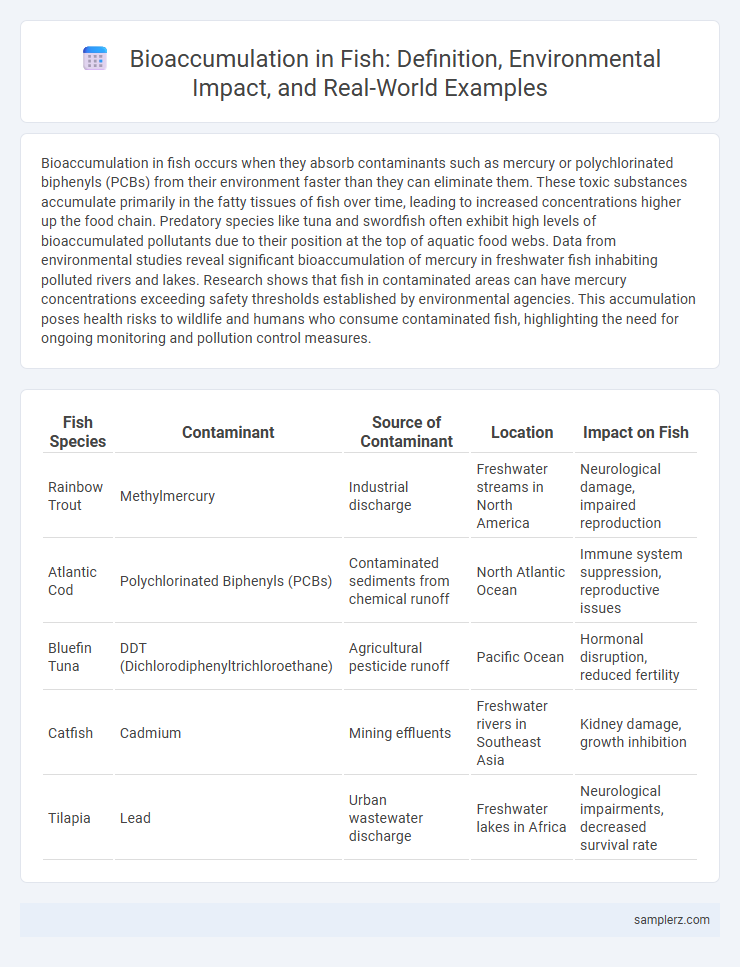Bioaccumulation in fish occurs when they absorb contaminants such as mercury or polychlorinated biphenyls (PCBs) from their environment faster than they can eliminate them. These toxic substances accumulate primarily in the fatty tissues of fish over time, leading to increased concentrations higher up the food chain. Predatory species like tuna and swordfish often exhibit high levels of bioaccumulated pollutants due to their position at the top of aquatic food webs. Data from environmental studies reveal significant bioaccumulation of mercury in freshwater fish inhabiting polluted rivers and lakes. Research shows that fish in contaminated areas can have mercury concentrations exceeding safety thresholds established by environmental agencies. This accumulation poses health risks to wildlife and humans who consume contaminated fish, highlighting the need for ongoing monitoring and pollution control measures.
Table of Comparison
| Fish Species | Contaminant | Source of Contaminant | Location | Impact on Fish |
|---|---|---|---|---|
| Rainbow Trout | Methylmercury | Industrial discharge | Freshwater streams in North America | Neurological damage, impaired reproduction |
| Atlantic Cod | Polychlorinated Biphenyls (PCBs) | Contaminated sediments from chemical runoff | North Atlantic Ocean | Immune system suppression, reproductive issues |
| Bluefin Tuna | DDT (Dichlorodiphenyltrichloroethane) | Agricultural pesticide runoff | Pacific Ocean | Hormonal disruption, reduced fertility |
| Catfish | Cadmium | Mining effluents | Freshwater rivers in Southeast Asia | Kidney damage, growth inhibition |
| Tilapia | Lead | Urban wastewater discharge | Freshwater lakes in Africa | Neurological impairments, decreased survival rate |
Introduction to Bioaccumulation in Aquatic Ecosystems
Bioaccumulation in aquatic ecosystems occurs when fish absorb toxic substances like mercury or polychlorinated biphenyls (PCBs) from water and their diet, leading to increased concentrations in their tissues over time. This process affects species at all trophic levels, posing risks to aquatic life and humans consuming contaminated fish. Monitoring bioaccumulation helps assess environmental health and the long-term impact of pollutants in water bodies.
How Bioaccumulation Occurs in Fish
Bioaccumulation in fish occurs when they absorb toxic substances like mercury or polychlorinated biphenyls (PCBs) from contaminated water and consume smaller organisms containing these pollutants. These harmful chemicals accumulate in fatty tissues faster than they are broken down or excreted, leading to higher concentrations over time. This process poses significant risks to aquatic ecosystems and human health through the consumption of contaminated fish.
Common Pollutants Responsible for Bioaccumulation
Heavy metals such as mercury and lead are common pollutants responsible for bioaccumulation in fish, often originating from industrial discharge and mining activities. Persistent organic pollutants (POPs) like polychlorinated biphenyls (PCBs) and DDT, used in agriculture and manufacturing, also accumulate in aquatic organisms, leading to toxic effects. These substances concentrate in fish tissues over time, posing significant risks to aquatic ecosystems and human health through seafood consumption.
Mercury Bioaccumulation in Tuna and Swordfish
Mercury bioaccumulation in tuna and swordfish occurs as these predatory fish consume smaller contaminated organisms, leading to high concentrations of methylmercury in their tissues. This toxic compound poses significant health risks to humans and marine ecosystems due to its persistence and biomagnification through food webs. Monitoring mercury levels in tuna and swordfish is crucial for seafood safety and environmental protection efforts.
Polychlorinated Biphenyls (PCBs) in Freshwater Fish
Polychlorinated Biphenyls (PCBs) accumulate in freshwater fish through contaminated sediment and water, leading to elevated concentrations in species like largemouth bass and catfish. These persistent organic pollutants bioaccumulate in fatty tissues, causing health risks including reproductive harm and immune system disruption. Monitoring PCB levels in freshwater ecosystems is crucial for managing fish safety and protecting aquatic biodiversity.
DDT Residues Detected in Predatory Species
DDT residues bioaccumulate in predatory fish species such as largemouth bass and trout, where concentration levels can be hundreds of times higher than in surrounding water. Studies reveal DDT metabolites like DDE persist in fatty tissues, causing reproductive and neurological impairments. Monitoring these bioaccumulated toxins is crucial for assessing ecosystem health and food chain risks.
Cadmium and Lead Concentration in Bottom-Feeding Fish
Cadmium and lead concentrations in bottom-feeding fish, such as catfish and carp, exemplify bioaccumulation due to their habitat close to contaminated sediments. These heavy metals persist in aquatic environments and accumulate in fish tissues over time, posing significant ecological and human health risks. Monitoring metal levels in these species provides critical data for assessing pollution impact and enforcing water quality standards.
Impact of Bioaccumulation on Human Health via Fish Consumption
Bioaccumulation of mercury in fish species such as tuna and swordfish poses significant health risks to humans, including neurotoxicity and developmental impairments. Consuming contaminated fish leads to mercury accumulation in the body, increasing the risk of cardiovascular diseases and cognitive deficits, particularly in pregnant women and young children. Regular monitoring of mercury levels in seafood is essential to minimize exposure and protect public health.
Case Study: Bioaccumulation in the Great Lakes Fish Population
Mercury contamination in the Great Lakes has led to significant bioaccumulation in fish species such as lake trout and walleye, posing health risks to both wildlife and humans consuming these fish. Studies show that methylmercury concentrations increase up the food chain, resulting in higher toxin levels in predatory fish compared to smaller forage fish. Monitoring data from the Great Lakes Fish Monitoring Program highlights persistent mercury pollutants despite regulatory efforts, emphasizing ongoing environmental and ecological challenges.
Strategies to Reduce Bioaccumulation in Aquatic Food Chains
Fish accumulate harmful toxins like mercury and PCBs through bioaccumulation, posing risks to aquatic food chains and human health. Implementing stricter regulations on industrial discharge, promoting the use of eco-friendly chemicals, and restoring wetlands can significantly reduce pollutant levels in water bodies. Enhancing monitoring programs and encouraging sustainable fishing practices further mitigate bioaccumulation impacts in aquatic ecosystems.

example of bioaccumulation in fish Infographic
 samplerz.com
samplerz.com